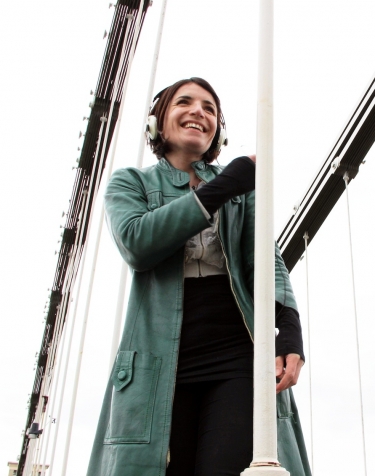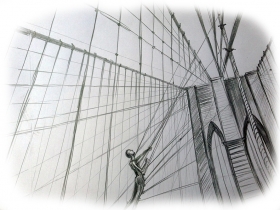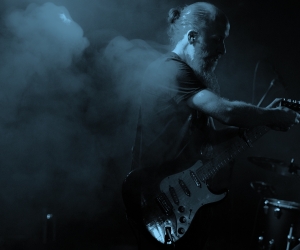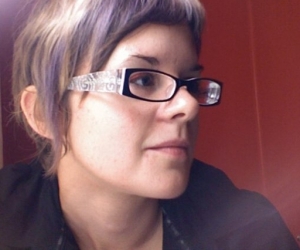Di Mainstone, inventor of the Human Harp, describes herself as a “bridge botherer.” But to be accurate, her bridge-bothering activities are fairly recent. Before bridges (the Human Harp has, to date, played bridges in Brooklyn, Omaha, and Bristol) came mood-sensitive kinetic outfits and prosthetic sound devices. In Mainstone’s tiny studio, perched atop a disused Victorian viaduct in east London, there is just enough room for the two of us, the innards of two upright pianos, and hanging space on the walls for a few of her sonic artifacts—beautifully crafted shapes that combine organic forms with an unfettered sculptural imagination: the Whimsichord, the Digi-Bow, and the Serendipitichord. They are instruments, but not as we know them.
The British artist is not alone in imagining a new sonic future: she invented these instruments with a team of creative collaborators that includes computer programmers, industrial designers, dancers, and engineers of all types. “I combine wearable things,” says Mainstone, whose original training was in fashion design. “There’s a bit of technology, sculpture, performance. I squish them altogether, and the outcome—for the last five years—has been wearable musical instruments that are ambiguous in shape but inspire people to play with them and clip them to their body in all sorts of ways, so they can coauthor them. They can trigger sounds as they move through space, and those sounds are triggered by sensors that are usually embedded within them.”
Sonification—the practice of pulling new sounds from unconventional places or transliterating one form of data into a sounding corollary—has for some time been a fertile area for composers, visual artists, and technicians: think of Milton Mermikides’ compositions that incorporate biomedical data; the hyperinstruments of MIT’s Opera of The Future research group; or the flora and fauna that Miya Masaoka incorporates into her own sound palate. But just because sonification is possible (and made much easier now with digital technology), it does not necessarily follow that these new sound-producing instruments, whatever their formats, are an end in themselves. It’s the challenge of navigating the difference between the method, the invention, and the methodology—what one does with it—that Mainstone has risen to. “I am trying to open up the process of music-making, so that the players of the instrument, whom I call movicians, can make a playful exploration of what sound and music can be.”
But there is much more to it than that. Mainstone is passionate about the importance of the social and historical networks that tie her projects together. She speaks about the social clothing made by artist-designers Lucy and Jorge Orta—suits that zip together to share human warmth, sociability, and resources—as radical inventions. After a few years as a senior designer at U.K. cult labels Soochi and Choosi, Mainstone left the country in 2004 for a quest to figure out the next step. The hybrid area she landed in was arrived at quite naturally.
In 2005, Mainstone was invited by Sara Diamond, then director of research at the Banff Centre, to head up a project on responsive clothing at the centre’s New Media Institute. Mainstone and her engineer colleagues developed a hooded dress called Company Keeper. “I used my own experience of feeling nervous in a new place,” recalls Mainstone. “A worrybead hung off the dress’s hoody drawstrings, a lovely clumpy thing that I made in the kiln. Inside the bead we embedded an accelerometer and programmed it to pick up on actions. Its gesture-recognition technology responded to moods picked up by fiddling and twiddling with the bead and different sounds, and you would hear them within the hood on embedded headphones.” The sounds were transmitted via Bluetooth, using an early smartphone and specially designed software.
From Banff, Mainstone went to Montreal, where she and Joanna Berzowkska, founder and research director of the design-research studio XS Labs, created a collection called Skorpions—kinetic costumes combining art and fashion. Berzowkska had been working with a shape-memory alloy that expands or contracts, rather like a muscle, in reaction to heat—in this case, a low electrical current. Threading an alloy filament through the fabric of the Skorpions meant that the costumes simulated a life of their own.
“During my two years in the XS Labs, I turned from things that were recognizable clothes to sculptural things,” Mainstone says. “There was no turning back.”
From January to September 2009, Mainstone was a resident artist at the Eyebeam Art and Technology Center in New York, where she started obsessively drawing wearable sculptures. “Eyebeam’s director Amanda McDonald Crowley said it was important that I get outside the lab and soak up things in order to think more broadly. So I started going to the Brooklyn Bridge,” Mainstone recalls. “I loved hearing the cacophony of voices and the mix of voices that became a human hum and then the traffic layers. It became an urban opera. I saw these as journey sounds and wondered if they travelled through the wires. I wondered if there was a way of creating an instrument that clipped to the bridge. I saw the shape of the bridge as a giant harp. I had a very strong vision of a woman connected to the bridge, almost an extension of it. I knew she had an important function. At that time I couldn’t work out what it was, but it stuck with me for the next few years.” [ABOVE: "Dream on Brooklyn Bridge" is one of Mainstone's first sketches for the Human Harp.]
“Sometimes you just have to make things”
In late 2009 Mainstone started her current residency at the school of electronic engineering at Queen Mary University of London. She was by that time using more and more architectural materials—a “rebellion against fashion,” she says. The idea of the performative body became her main source of inspiration. The bridge idea hadn’t gone away, and the 130th birthday of the Brooklyn Bridge in 2013 provided the occasion to realize it.
With the help of some funding from Queen Mary, Mainstone set up a public meeting at Brooklyn’s Dumbo Arts Center to explain her idea of bridge music. There she met Julie Martin, widow of scientist Billy Klüver, who in 1966 cofounded with artist Robert Rauschenberg and others the group Experiments with Arts and Technology. Martin helped out Mainstone by setting up a meeting with a PR person, a choreographer, and a curator. “It was the boost that got everything going,” recalls Mainstone. “I realized that the most important part of the project was the term bridge: it was a metaphor for my process. If I opened it up I could share the resources to make it happen.”
There was, she admits, a huge amount of trial and error. Dancer Hollie Miller was recruited to attach herself to the bridge as a sounding bow (DISCOVER
the Digi-Bow and more photos in the FALL 2015 print issue), while Mainstone and her team figured out how to trigger bridge sounds. Experts came forward with details on the physical properties of wire and tension, the harmonic distances of strings, and the like. Contact mikes were fixed to the bridge cables, which were then percussed with a mallet. The resulting subsonic sounds were translated to an audible level. “There was a lovely drone,” Mainstone says. “We were finally listening to the physical nature of the bridge.”
The result is beguiling—a shimmering, thrumming soundscape that floats without rhythm in a kind of perfect space. The resulting success and media coverage earned Mainstone and the Human Harp an invitation to play the Bob Kerrey Suspension Bridge. “The great thing about the Kerrey bridge is that it’s really musical—it makes a Star Wars twanging sound,” she says. The cross-interlaced wires meant that sound travelled more easily up Kerrey’s cables than Brooklyn’s twisted steel ones. This was good, but Mainstone needed to figure out how to instigate the cable’s sounding in the first place. The solution came in the form of a mechanical hammer—modelled on a dog ball thrower attached to a window-cleaner’s extension pole—that would bonk the wires.
Dog leads. Ball throwers. Plumber’s rubber. This gloriously berserk inventiveness points to the sheer fun of what Mainstone and her collaborators are doing. Not surprisingly, projects about making monumental music continue to draw an array of interested parties. Recently, Mainstone has had conversations with Steinway & Sons (if anyone knows about the mechanics of a piano hammer, they do) and with Arup, a global structural engineering company. Help from these experts was put to good use for the Human Harp’s 2015 performance on the 412-metre Clifton Suspension Bridge, which spans the Avon Gorge in Bristol, England. Accelerometers, which measure the speed of vibrations, were attached to twelve bridge rods, which were then “donged,”
providing what the team calls “the Clifton scale.”
“It’s not pure at all. That’s the charm of it,” Mainstone says.
The science of music and the art of engineering meet in Mainstone’s musical enterprises. And, for the moment, she’s still thinking big. The resonant qualities of buildings around the world are igniting her interest. It feels like an important idea: putting listening and sounding at the centre of a built environment is a way to humanize it.
Top photo of Di Mainstone by: Jesse D Lawrence, courtesy of Sennheiser.
ON THE CD: Play The Bridge, The Bridge, Klop Klonk




